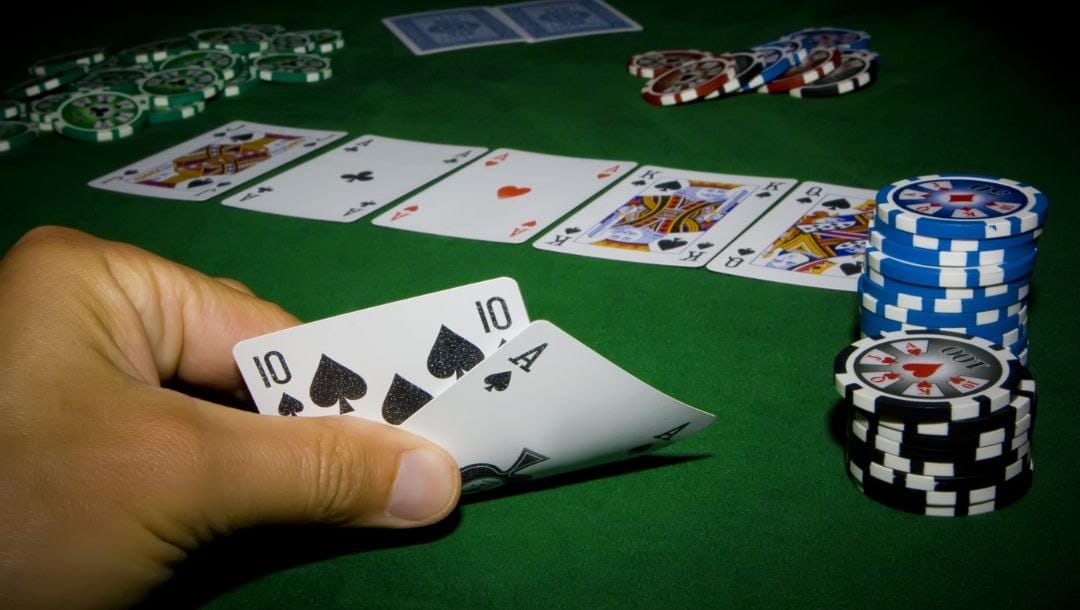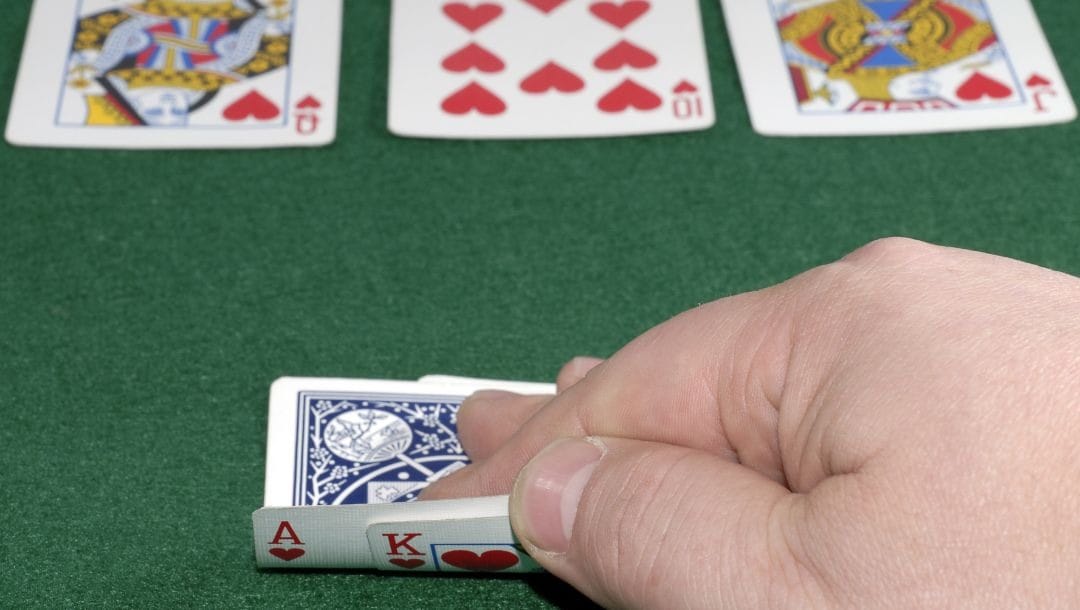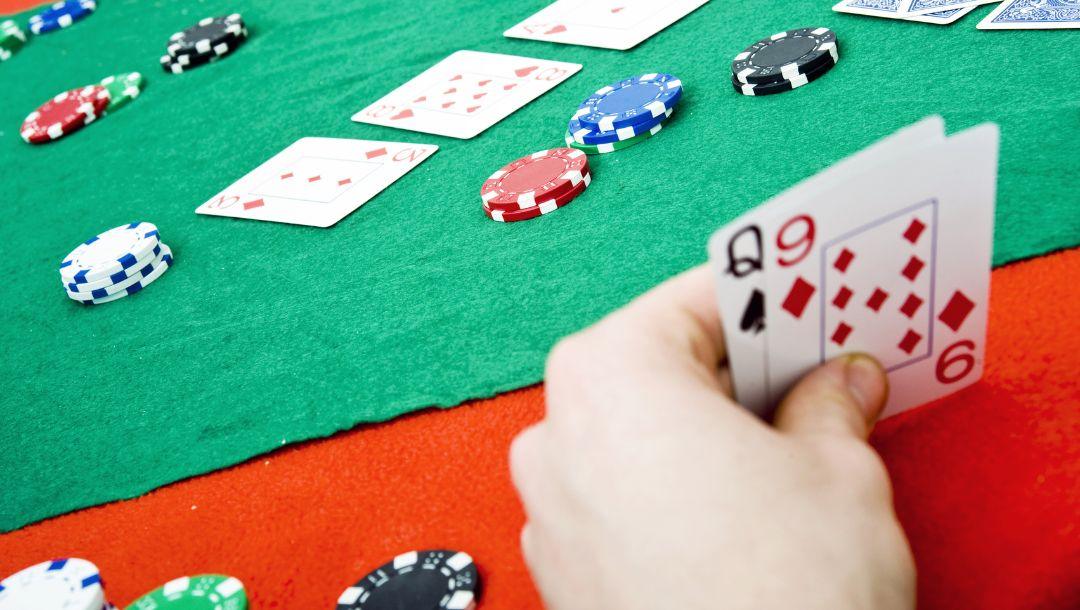Plan to succeed in poker with a strategy for when you miss the flop. Read on to discover when to play and when to fold when the flop comes dry.
What Should I Do When I Miss the Flop in Poker?

Online poker is a game of revelations. The first moment of revelation comes when you receive your hole cards. Immediately, you have some idea of whether you potentially have the strongest hand, whether your cards are middling at best, or if they’re junk. This sets up the preflop betting round in which players bet and grow the pot according to the perceived value of their holdings. Then comes the flop, which reveals whether these bets are well-founded or misjudged.
Knowing how to play postflop is an extremely important part of any successful poker strategy. So, what comes after the flop in poker? What can you do if you miss the flop? Here’s what you should know for your poker postflop play.
What Is the Flop in Poker?
There are no stupid questions in poker, least of all this one. When you’re playing poker, whether it be a round of Omaha poker, a game of Texas hold’em online, or any other variation, the flop marks the second round of betting in a hand. After players have either folded or committed themselves to the pot in the preflop betting round, the dealer burns a card and lays the first three community cards on the board. Now that you know what kind of hand you’ve got, you can judge whether you can improve your hole cards with a potential flush or straight draw or whether you’ve got a made hand.
These happy scenarios don’t always present themselves, though. In fact, two-thirds of the time, you can expect to miss the flop. When a player “misses the flop,” it means that the three community cards do not complement their hole cards to create a stronger hand. An event with such a high degree of probability calls for contingency planning.
Your Options When You Miss the Flop
Players often use the information from the flop to assess the strength of their own hand and the potential strength of their opponents’ hands. Depending on how well their starting hand interacts with the flop, players can then decide whether to check, fold, or continue betting in their postflop poker play.
So, what can you do when you miss the flop in poker? It’s a postflop question every player should have an answer to. If you miss the flop and the community cards don’t offer much potential for improvement, there are three main postflop strategy options you could try. Either you check or possibly call to see the turn, fold, or bluff aggressively and hope your opponents will fold. You are allowed to raise, though this isn’t a recommended strategy if you’ve missed the flop.
A Missed Flop With Potential

A missed flop isn’t always bad news when you’re playing poker games online. Sometimes, in the best-case scenario, a missed flop will bring high-value cards or present other playable opportunities. Say you have the ace and king of diamonds in the hole, and the flop comes jack of clubs, 10 of spades, and 3 of diamonds. You’ve missed the flop, but your hand now has the potential to draw a gutshot straight or a backdoor flush.
These are good enough odds to keep your hand in play but not enough to play aggressively with. If you make a continuation bet, an opponent could simply raise, leaving you in a tight spot. As a result, the best approach is to check in hopes of seeing the turn. If an opponent bets, you can put them on a range and evaluate whether it’s worthwhile getting further involved.
A Missed Flop With an Outside Chance
Another missed flop that may be worth continuing is the kind that gives you a backdoor and strong overcard potential but not much else. Say you’re holding that same ace and king of diamonds, but this time, the flop comes as the queen of diamonds, 7 of spades, and 5 of clubs. Once again, you’ve missed the flop, but at least you have a backdoor flush draw as well as two overcards for a top pair. It’s definitely worth checking to see the turn, although it doesn’t give you much to work with. If, however, after this flop, an opponent raises, the chances are good that they have a made hand. The chances of hitting your draw on the turn are no better than they usually are, so you’ll want to either fold or bluff aggressively in hopes of finding your opponent’s folding point.
A Hopeless Missed Flop
The worst-case scenario is a flop that leaves you dead in the water. Say you’re holding the ace and king of diamonds again, and the flop comes as 9 of spades, 8 of spades, and 7 of hearts; this flop has killed you. The board is wet, with plenty of drawing potential — only there’s none for you. Your hole cards don’t connect with anything, and there isn’t an overcard in sight. A great many poker players would simply fold and move on. This is the safest thing to do unless you choose to bluff with a great deal of aggression. Just be careful that you don’t bluff yourself into deep water against your opponent’s made hand.
Bluffing After the Flop

If you’re in position and the board has a very dry texture postflop, it can pay off to bluff aggressively. Say you’re on the button, and the flop comes with an ace and a couple of low, disconnected cards such as 2 of spades and 8 of clubs; the aggressive play here would be to make a continuation bet of a third to half the pot. This is big enough to scare off weak-handed players but low enough to reduce the cost of folding when called. In the long run, betting on missed flops in this way will lose less money than folding all the time. Conversely, fluffing after wet flops — ones with the potential for several draws — is a poker postflop strategy best avoided.
Tips for Optimizing Your Strategy When You Miss the Flop
Navigating the postflop stage effectively involves more than just the cards on the table; it requires a nuanced strategy. Here are four key tips to enhance your decision-making when you miss the flop:
1. Carefully Applied Aggression
As helpful as it can be, there is a time and place for aggression in your poker strategy. If you miss the flop, you shouldn’t automatically opt for an aggressive strategy and make a bet — you need to make sure that your bets are purposeful and made in carefully chosen spots. On dry poker flops, for example, you can consider adopting a more aggressive stance, especially if you were the more aggressive player preflop.
2. The Importance of Position
Your position at the table is a very important consideration for your poker strategy, especially if you’ve missed the flop. It’s a lot easier for players to apply pressure when they have the table position, so it’s a better time to bet. When you’re playing poker out of position, it’s usually best to exercise caution and be selective with your bluffs.
3. Considering Bet Sizing When Bluffing
Choosing the right bet size after the flop is always important, but it becomes even more crucial if you’ve missed the flop. When you’re bluffing after a missed flop, it’s important to be consistent with your bet sizing, keeping the same bet sizes for both your bluffs and value bets. But, you need to be smart about it to keep your more vigilant opponents from catching on. Don’t go overboard with your bets automatically — think about the board texture and your opponent’s likely range. On dry flops, you can get a bit more aggressive, but on trickier ones, adjust your bet size to ward off potential draws.
4. Reading Opponents’ Folding Habits
Keep an eye out for opponents who fold more frequently and capitalize on their tendencies. Increase your aggression against these players, strategically placing well-timed bets to exploit their predictable play. Using tracking tools like HUDs can also help you gather insights into your opponents’ folding behaviors.
Remember, a successful postflop poker strategy goes beyond the cards; it involves adapting to the unique playing styles of your opponents. This is why consistent learning is so important for poker players — you need a thorough understanding of the game in order to successfully adapt your strategy while you play. By integrating these opponent-specific considerations into your postflop game and making sure you continue to learn as much of the game as possible, you can improve your ability to make informed decisions and maximize your overall success at the poker table.
Play Poker Online at BetMGM
Don’t miss the poker boat — register at BetMGM to hone your skills to the highest level they can reach. The path of progress runs through low- to high-stakes cash games and daily, weekly, and monthly poker tournaments. In addition to playing poker games online, you can visit the online casino to explore a broad range of online slots and casino table games such as blackjack, roulette, and baccarat, including live dealer variations. Hit the gaming spot with BetMGM.


